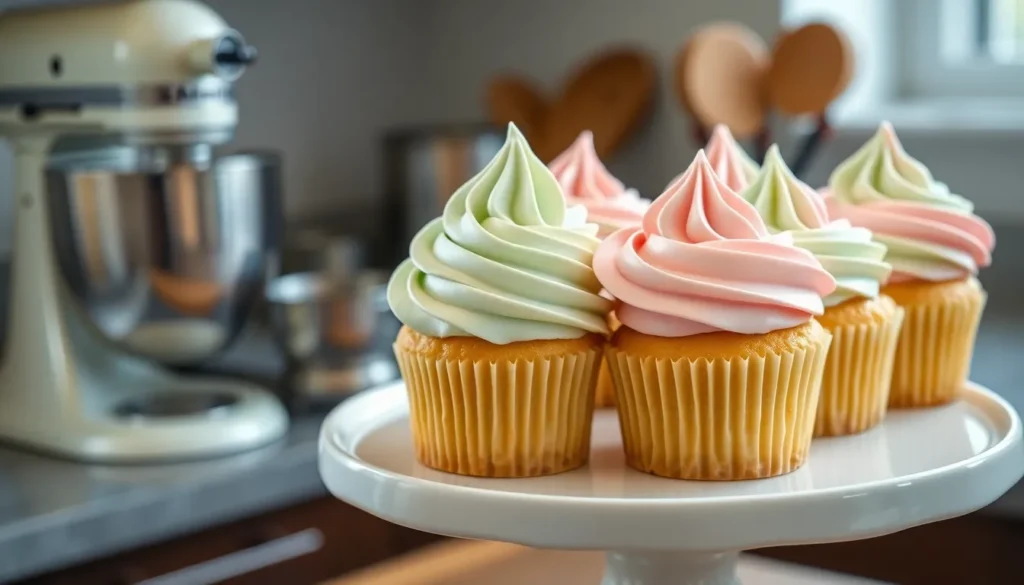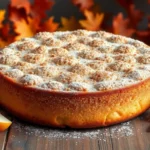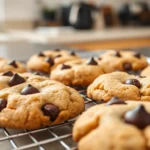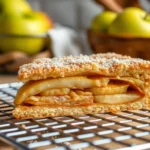Swiss meringue buttercream transforms ordinary cakes into bakery-worthy masterpieces with its silky smooth texture and luxurious mouthfeel. Unlike traditional American buttercream that can feel overly sweet and heavy, this European-style frosting strikes the perfect balance between richness and lightness.
We’ve perfected this technique after countless batches because Swiss meringue buttercream truly elevates every dessert it touches. The secret lies in gently heating egg whites and sugar before whipping them into glossy peaks, then gradually incorporating butter for that signature velvety finish.
What makes this frosting absolutely irresistible is its versatility – it pipes beautifully, spreads like a dream, and accepts flavors effortlessly. Whether you’re creating wedding cakes or weekend cupcakes, this professional-quality buttercream delivers consistent results that’ll have everyone asking for your secret.
What Is Swiss Meringue Buttercream
Swiss meringue buttercream represents the gold standard of cake frostings that combines European technique with luxurious results. We create this sophisticated buttercream by gently heating egg whites and granulated sugar together in a double boiler until the mixture reaches 160°F. This crucial temperature ensures food safety while dissolving the sugar completely.
The heated mixture transforms into glossy peaks when we whip it in a stand mixer until it cools to room temperature. We then gradually incorporate softened butter one piece at a time until the frosting becomes silky smooth and perfectly emulsified. This methodical process creates a stable buttercream that maintains its texture at room temperature.
Unlike traditional American buttercream that relies heavily on powdered sugar, Swiss meringue buttercream achieves its sweetness from the dissolved granulated sugar in the meringue base. We appreciate how this technique eliminates the gritty texture often found in other buttercream varieties. The result delivers a clean taste that enhances rather than masks the flavors of our cakes and cupcakes.
Professional bakers favor Swiss meringue buttercream for its exceptional stability and workability. We can pipe intricate decorations that hold their shape beautifully without melting or losing definition. The frosting spreads smoothly across cake surfaces and creates flawless finishes that photograph wonderfully.
Temperature control plays a vital role in achieving perfect Swiss meringue buttercream consistency. We ensure our butter reaches the ideal softened state while our meringue cools completely before combining them. This attention to detail prevents the common issues of curdling or separation that can occur with improper temperatures.
Swiss meringue buttercream serves as an excellent canvas for flavor additions since its neutral base complements both subtle and bold tastes. We can incorporate vanilla extract, fruit purees, chocolate, or liqueurs without compromising the frosting’s structure or smooth texture.
Equipment Needed
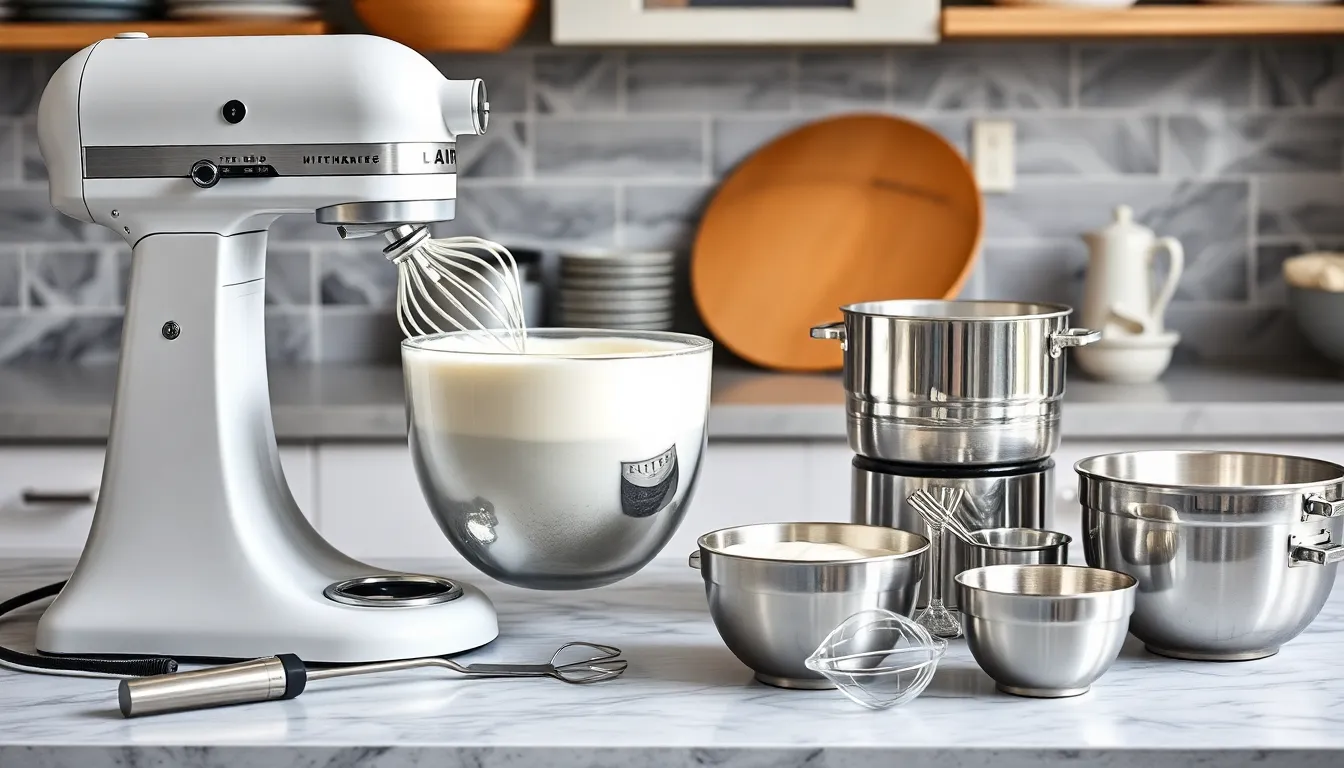
Creating the perfect Swiss meringue buttercream requires exact tools that ensure precision and success throughout the process. We recommend gathering all equipment before starting to maintain the proper workflow and temperature control essential for this technique.
Stand mixer with attachments forms the cornerstone of our equipment list. The whisk attachment creates the stable meringue base while the paddle attachment incorporates butter smoothly without deflating our carefully built structure. Hand mixers work as alternatives but require more time and effort to achieve the same silky results.
Double boiler setup provides the gentle heat necessary for safely cooking egg whites and dissolving sugar completely. We can create this using a heatproof bowl positioned over a pot of simmering water. The indirect heat prevents the eggs from scrambling while reaching the critical 160°F temperature.
Instant read thermometer ensures food safety and optimal sugar dissolution by accurately measuring our egg white mixture. Digital models offer the fastest readings and help us avoid overcooking the delicate proteins.
Multiple mixing bowls accommodate ingredient preparation and provide backup options if our primary bowl encounters any grease contamination. Stainless steel or glass bowls work best as they resist residual oils that can prevent proper meringue formation.
Precision measuring tools including cups and spoons guarantee consistent results every time we prepare this buttercream. Accurate measurements become especially crucial when scaling recipes up or down for different cake sizes.
| Equipment | Purpose | Alternative Options |
|---|---|---|
| Stand mixer | Creates stable meringue and incorporates butter | Hand mixer (requires more time) |
| Double boiler | Provides gentle, controlled heat | Heatproof bowl over simmering water |
| Instant thermometer | Ensures 160°F temperature accuracy | Digital probe thermometer |
| Mixing bowls | Ingredient prep and backup options | Multiple sizes recommended |
| Measuring tools | Guarantees recipe precision | Digital scale for weight measurements |
Ingredients
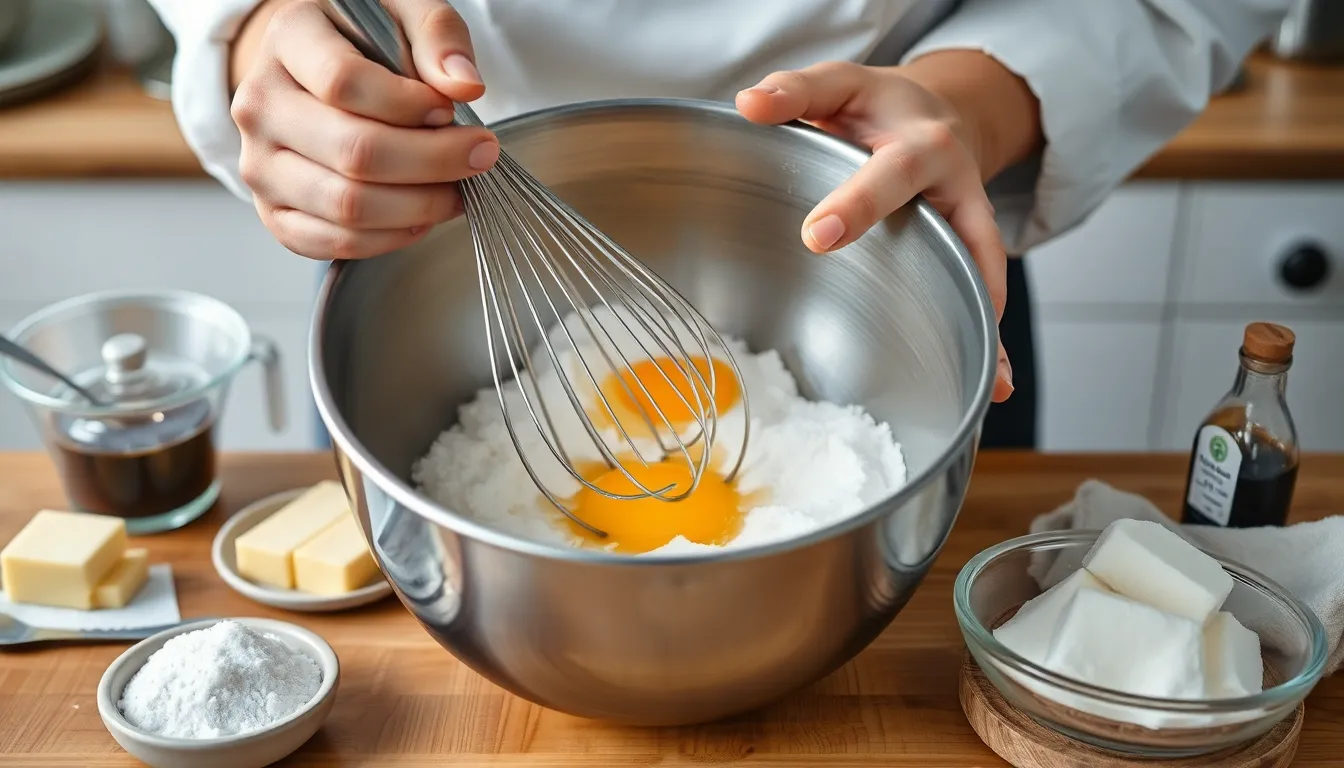
Our Swiss meringue buttercream requires just a handful of premium ingredients that work together to create that signature silky texture. We’ll divide these components into two essential categories for optimal preparation.
For the Swiss Meringue Base
- 5 to 7 large egg whites (5 to 7 ounces total)
- 1½ to 2 cups granulated sugar (300 to 400 grams)
- ¼ teaspoon kosher salt or fine sea salt
The egg whites serve as our foundation, providing structure and stability to the meringue. We use granulated sugar rather than powdered sugar because it dissolves completely when heated, eliminating any grittiness in our final buttercream. The salt enhances flavor balance and strengthens the protein structure in the egg whites.
For the Buttercream
- 1½ to 2 cups unsalted butter (3 sticks or 340 grams), softened but cooler than room temperature
- 1 to 2 teaspoons vanilla extract
Our butter must be properly tempered for successful incorporation into the meringue base. The butter should yield slightly to pressure but still maintain its shape when pressed. Vanilla extract adds depth and warmth to the neutral meringue base, though we can easily substitute or supplement with other flavorings based on our desired outcome.
Instructions
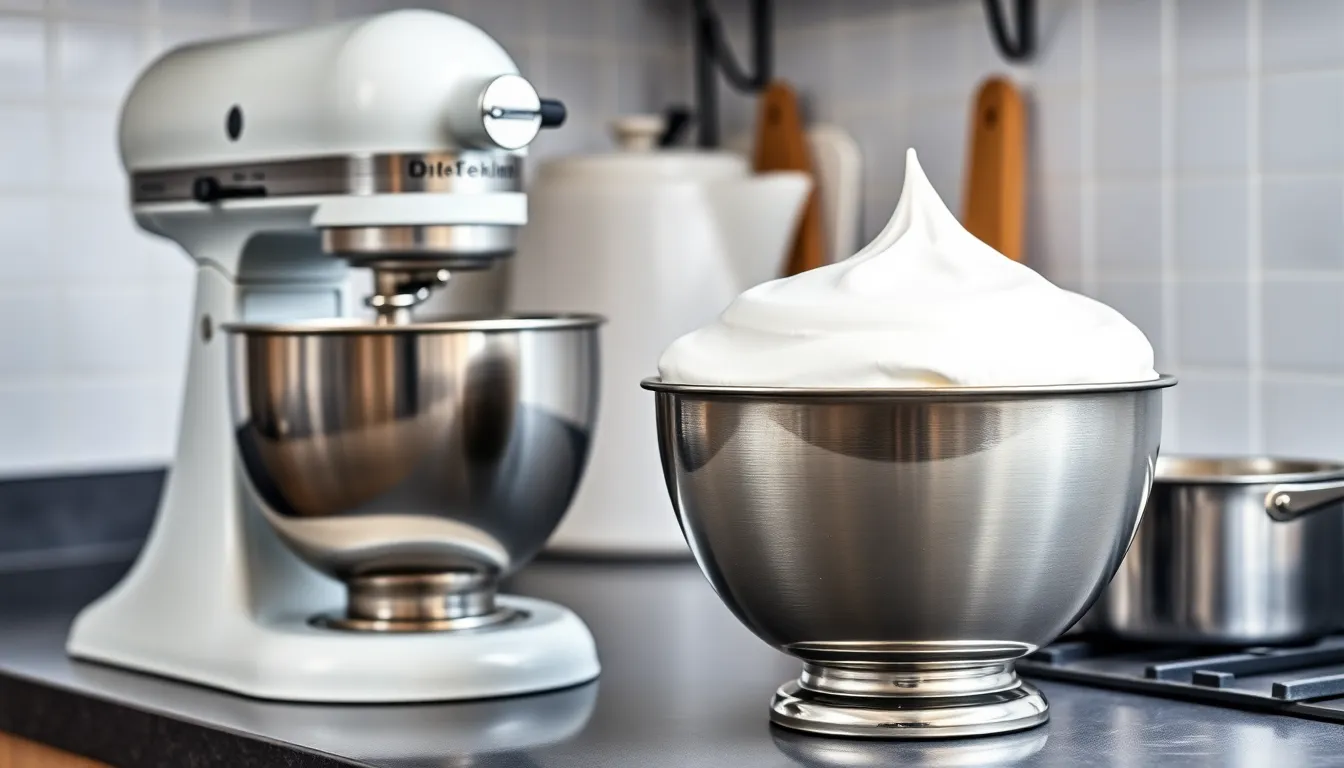
We’ll walk through each step to create perfectly smooth Swiss meringue buttercream that transforms your desserts into professional-quality masterpieces. The process requires attention to temperature and timing for optimal results.
Prep the Equipment
We begin by setting up our double boiler system with a pot of water brought to a gentle simmer on the stove. Our mixing bowl must be completely clean, dry, and grease-free since any residue will prevent the meringue from forming properly.
The stand mixer should be positioned nearby with both whisk and paddle attachments ready for use throughout the process. We ensure our instant-read thermometer is calibrated and accessible for monitoring temperature accurately.
Make the Swiss Meringue
We combine the egg whites and granulated sugar directly in our clean mixing bowl, whisking them together briefly. The bowl goes over our simmering water, ensuring the bottom doesn’t touch the water surface to prevent overcooking.
Constant whisking becomes essential as we heat the mixture until it reaches exactly 160°F and the sugar dissolves completely. This temperature eliminates any food safety concerns while creating the foundation for our buttercream’s stability.
Cool the Meringue
We transfer the heated mixture to our stand mixer fitted with the whisk attachment and beat on medium-high speed. The meringue develops stiff, glossy peaks over 15 to 20 minutes of continuous whipping.
Our bowl should feel completely cool to the touch before proceeding to the next step. This cooling process ensures the butter won’t melt when incorporated, maintaining the buttercream’s structure.
Add the Butter
We switch to the paddle attachment and begin adding softened butter one tablespoon at a time. Each addition must be fully incorporated before adding the next piece to prevent the mixture from breaking.
The buttercream may appear curdled initially, but continued mixing transforms it into a silky smooth consistency. Patience during this stage ensures our final product achieves the desired luxurious texture.
Flavor the Buttercream
We add vanilla extract and a pinch of salt, mixing until the flavors distribute evenly throughout the buttercream. Additional flavorings or food coloring can be incorporated at this stage based on our exact recipe requirements.
The finished buttercream should hold its shape when piped while spreading effortlessly across cake surfaces. Our Swiss meringue buttercream is now ready for immediate use or storage for later application.
Troubleshooting Common Issues
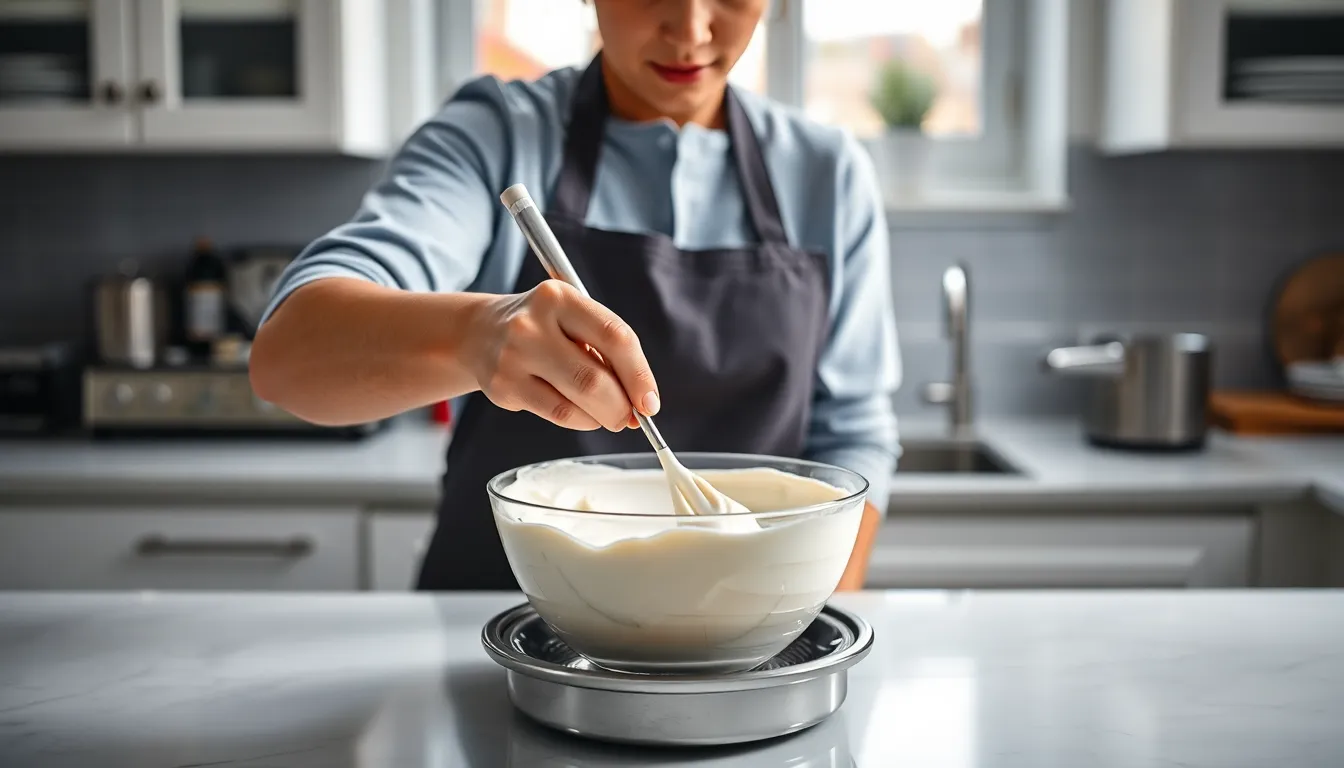
Even with precise technique, Swiss meringue buttercream can occasionally present challenges during preparation. Understanding how to identify and fix these common issues will help you achieve perfect results every time.
Fixing Curdled Buttercream
Curdled buttercream occurs when the butter temperature is too cold or when butter gets added too quickly to the meringue base. The mixture appears separated and lumpy instead of smooth and creamy.
We recommend gently heating the buttercream by placing the bowl over a warm water bath until it starts to soften. Remove the bowl from heat and whip the mixture until it becomes smooth and creamy again. This gradual warming process allows the butter to properly emulsify with the meringue.
Temperature control remains crucial throughout this process. The butter should reach approximately 60°F (16°C) before continuing with the whipping process.
Fixing Too Soft Buttercream
Soft or soupy buttercream typically results from butter that’s too warm or from adding butter before the meringue has cooled sufficiently. The mixture appears runny and lacks the structure needed for proper piping or spreading.
Place the buttercream in the refrigerator for 15-20 minutes to firm up the butter component. This chilling period allows the butter to reach the proper consistency for successful emulsification.
After chilling, whip the buttercream again until it reaches the desired consistency. The mixture should hold its shape when piped and spread easily without being too loose.
Fixing Too Stiff Buttercream
Overly stiff buttercream occurs when the mixture becomes too cold or when the butter wasn’t softened adequately before incorporation. The buttercream appears dense and difficult to spread or pipe smoothly.
Warm the buttercream slightly by placing it over a warm water bath until it softens just enough to become workable. Monitor the temperature carefully to avoid overheating, which could cause the opposite problem.
Whip the slightly warmed buttercream until it becomes smooth and creamy. Using an instant-read thermometer helps maintain the ideal temperature of around 60°F (16°C) for optimal consistency.
Flavor Variations
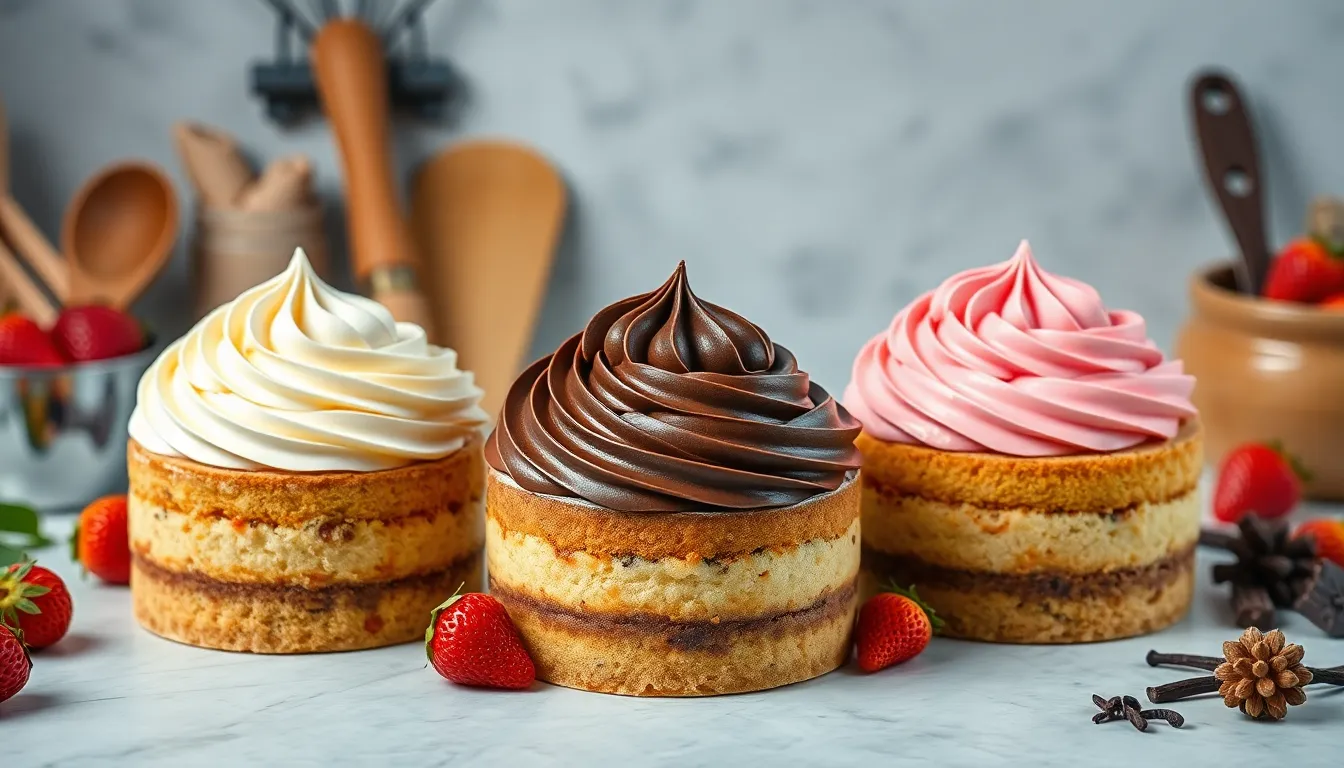
Our Swiss meringue buttercream base serves as the perfect canvas for creating stunning flavor combinations that will transform your desserts. The neutral foundation allows us to incorporate various flavors while maintaining the signature silky texture and stability that makes this buttercream so exceptional.
Vanilla Swiss Meringue Buttercream
We begin with the classic vanilla variation that showcases the buttercream’s naturally smooth texture and balanced sweetness. The addition of pure vanilla extract creates a clean flavor profile that highlights the buttercream’s luxurious mouthfeel without overwhelming the palate. A pinch of salt enhances the vanilla notes and provides depth to the overall taste.
This timeless flavor works beautifully with any cake base and offers versatility for both simple and elaborate decorating projects. We recommend using high-quality pure vanilla extract rather than imitation vanilla to achieve the best results. The vanilla Swiss meringue buttercream maintains its pipeable consistency while delivering a sophisticated flavor that professional bakers consistently choose for wedding cakes and special occasion desserts.
Chocolate Swiss Meringue Buttercream
Our chocolate variation transforms the base buttercream into a rich and decadent frosting that chocolate lovers adore. We achieve the best results by incorporating either melted and cooled high-quality chocolate or premium cocoa powder into the completed buttercream base. The chocolate must be completely cooled before folding it in to prevent the buttercream from breaking or becoming too soft.
When using melted chocolate we recommend allowing it to reach room temperature before incorporation. Alternatively cocoa powder creates a lighter chocolate flavor while maintaining the buttercream’s signature texture. We fold the chocolate additions carefully into the finished buttercream to preserve the airy consistency that makes Swiss meringue buttercream so special.
The chocolate version retains all the stability and workability of the original while adding sophisticated cocoa notes that pair exceptionally well with vanilla cakes or other chocolate desserts.
Strawberry Swiss Meringue Buttercream
We create our strawberry variation by incorporating strawberry puree or freeze-dried strawberry powder into the completed buttercream base. Fresh strawberry puree requires reduction and cooling before addition to prevent excess moisture from breaking the delicate emulsion that gives Swiss meringue buttercream its structure.
Freeze-dried strawberry powder offers a more concentrated flavor and eliminates moisture concerns while providing beautiful natural color. We recommend processing the freeze-dried strawberries into a fine powder before folding them into the buttercream. This method delivers intense strawberry flavor without compromising the frosting’s stability.
The timing of flavor addition remains crucial for maintaining the buttercream’s texture and preventing separation. We always ensure our strawberry additions have reached room temperature before incorporating them into the finished buttercream. This attention to temperature control preserves the smooth consistency that makes Swiss meringue buttercream the preferred choice for professional decorating applications.
Storage Instructions
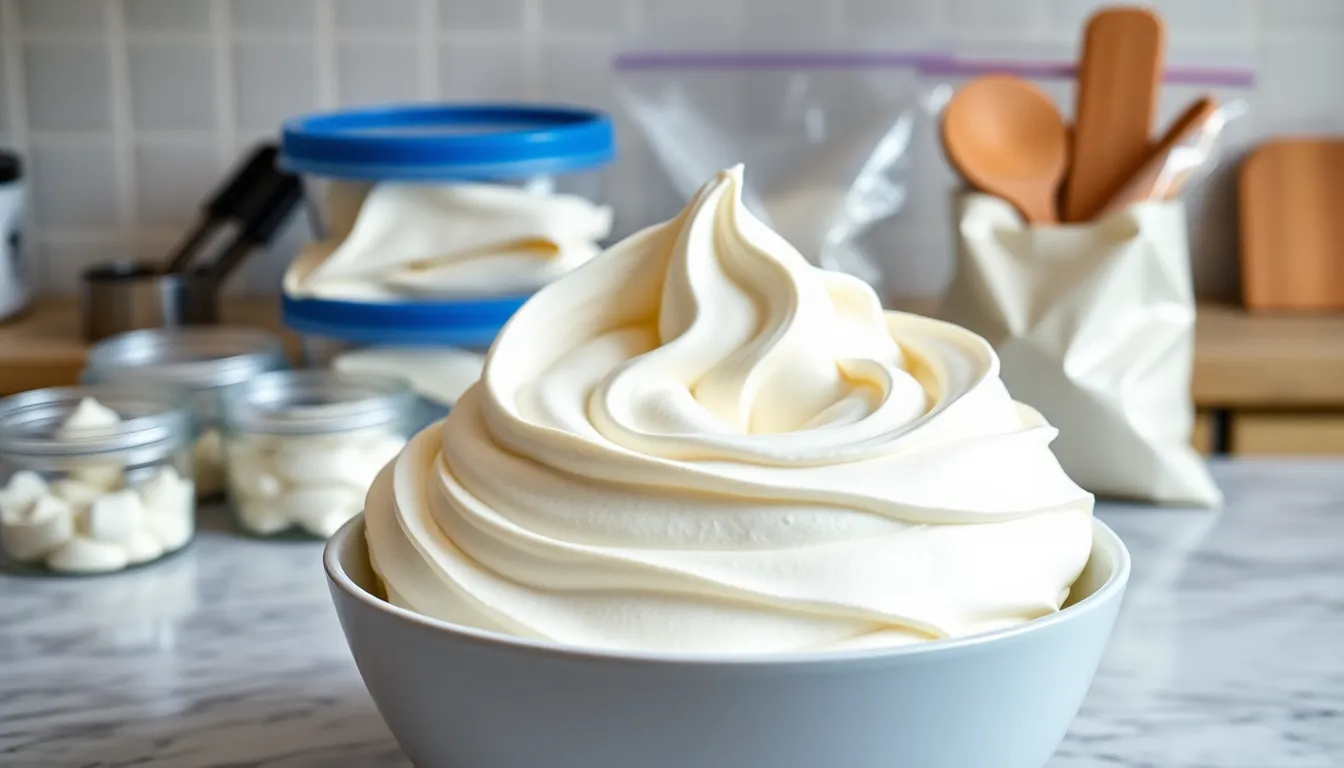
Proper storage keeps our Swiss meringue buttercream fresh and maintains its silky texture for future use. We can store this versatile frosting using several methods depending on when we plan to use it.
Refrigerator Storage
We can keep Swiss meringue buttercream covered in the refrigerator for up to 5 days for optimal quality. Store the buttercream in an airtight container to prevent it from absorbing odors and maintaining its pristine flavor. The cool temperature preserves the butter’s stability while keeping the meringue structure intact.
For room temperature storage in low humidity environments, our buttercream remains stable for 1 to 2 days when properly covered. This short-term storage works perfectly when we’re decorating cakes over a day or two.
Freezer Storage
Freezing extends our Swiss meringue buttercream’s life for up to 3 months without compromising quality. We recommend storing it in airtight freezer-safe containers or zip-top bags with excess air removed. Flattening the bag creates a thinner layer that thaws more quickly and evenly.
Label containers with the date to track storage time and ensure we use the buttercream within the recommended timeframe. The freezer’s consistent temperature maintains the buttercream’s structure and prevents deterioration.
Bringing to Room Temperature
Thawed Swiss meringue buttercream requires several hours to reach room temperature before use. We must allow completely frozen buttercream extra time if stored as a solid block. Once the buttercream reaches room temperature, re-whip it using a stand mixer or hand mixer on low speed, then increase to medium speed for 2 to 3 minutes.
The re-whipping process restores the buttercream’s creamy consistency and silky texture. Don’t worry if the buttercream appears separated or curdled after thawing – this separation is normal and reversible. Continue mixing until the buttercream becomes smooth and pipeable again. Always check for any off smells or signs of mold before using stored buttercream.
Uses and Applications

Swiss meringue buttercream transforms ordinary desserts into professional-quality masterpieces with its versatile applications. We recommend this buttercream for multiple baking projects due to its exceptional stability and refined texture that surpasses other frosting varieties.
Cake Frosting Excellence
Professional bakers consistently choose SMBC for coating and filling layer cakes because it delivers a smooth, polished finish that rivals bakery standards. The stable structure maintains its shape during transport and display while providing that coveted silky texture we discussed earlier. Wedding cakes and celebration tiers benefit tremendously from this buttercream’s ability to create clean edges and flawless surfaces.
Cupcake Decoration Mastery
Cupcake enthusiasts appreciate how Swiss meringue buttercream’s lightness prevents overwhelming the delicate cake base underneath. The balanced sweetness allows intricate piping techniques to shine without masking the cupcake’s flavor profile. We find this buttercream pipes beautifully through various tips for rosettes, swirls, and detailed decorative elements.
Macaron Filling Perfection
French macaron shells demand a filling that complements rather than competes with their delicate almond structure. SMBC’s creamy consistency pairs seamlessly with macaron cookies, creating the ideal texture contrast without excessive sweetness that could overpower these refined treats.
Advanced Piping Applications
Decorative cake artists rely on Swiss meringue buttercream for detailed piping work because its stable structure supports intricate designs. Buttercream flowers, borders, and sculptural elements maintain their definition thanks to the meringue base’s strength combined with butter’s richness.
Flavor Customization Options
The neutral foundation of SMBC accepts flavor additions effortlessly, transforming into chocolate, strawberry, lemon, or any desired variety through extracts, fruit purees, or melted ingredients. This adaptability makes one base recipe suitable for countless flavor combinations to match any dessert theme.
Color Versatility
Food coloring integrates smoothly into Swiss meringue buttercream’s pale base, allowing precise color matching for themed celebrations. The neutral starting point ensures vibrant, true-to-tone results whether creating pastel wedding colors or bold birthday party themes.
| Application Type | Temperature Stability | Sweetness Level | Professional Use |
|---|---|---|---|
| Layer Cake Frosting | 160-170°F preparation | Balanced | High |
| Cupcake Decoration | Room temperature stable | Not overly sweet | High |
| Macaron Filling | Consistent texture | Refined sweetness | Medium-High |
| Piping Details | Maintains shape | Controllable | High |
Pro Tips for Perfect Results
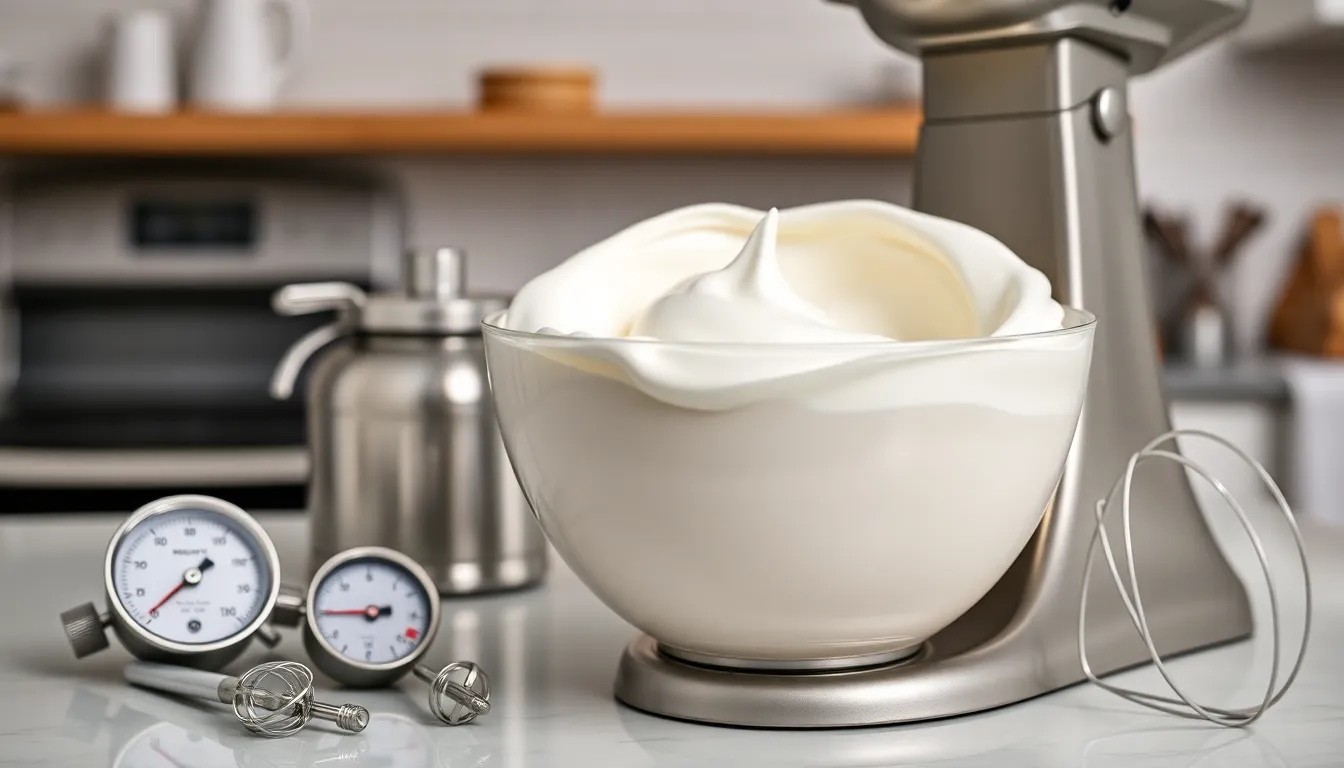
Temperature control stands as the most critical factor in achieving silky Swiss meringue buttercream. We need to heat our egg whites and sugar mixture to exactly 160°F to ensure complete sugar dissolution and food safety. Once the meringue forms stiff peaks, we must allow it to cool completely before incorporating butter. Adding butter to warm meringue creates a soupy disaster that requires starting over.
Butter preparation makes the difference between smooth success and frustrating failure. We recommend cooling unsalted butter to approximately 60°F for optimal incorporation. Room temperature butter that feels slightly cool to the touch works perfectly. Adding butter too quickly overwhelms the meringue base, so we incorporate it gradually while using the paddle attachment instead of the whip.
Equipment cleanliness cannot be overlooked when working with meringue bases. Any trace of grease or egg yolk prevents proper whipping and volume development. We thoroughly clean our mixing bowl and whisk attachment with hot soapy water, then wipe with white vinegar to remove any residual fat.
Whipping technique requires patience and proper timing to achieve professional results. We beat the heated egg white mixture until stiff glossy peaks form before switching to the paddle attachment. This creates the stable foundation needed for butter incorporation. Rushing this step produces weak meringue that cannot support the butter weight.
Re-whipping capability gives Swiss meringue buttercream remarkable versatility for storage and reuse. When our buttercream becomes too firm after refrigeration, we simply return it to room temperature and whip again until smooth. This restoration process maintains the original silky texture without compromising stability.
| Temperature Guidelines | Target Range |
|---|---|
| Egg white and sugar mixture | 160°F (71°C) |
| Butter temperature | 60°F (16°C) |
| Room temperature stability | 65-75°F |
Visual cues help us identify proper consistency throughout the process. The finished buttercream should coat the paddle attachment smoothly without appearing greasy or separated. Properly made Swiss meringue buttercream holds its shape when piped while remaining spreadable enough for smooth cake coverage.
Flavor additions work best when incorporated after achieving the perfect base consistency. We add vanilla extract and salt during the final mixing stage to preserve the buttercream’s stability. This timing prevents flavor ingredients from interfering with the delicate emulsion process.
Conclusion
Mastering Swiss meringue buttercream opens up a industry of professional-quality dessert possibilities. We’ve shown you that with the right technique and attention to temperature control this luxurious frosting becomes an achievable goal for any home baker.
The versatility of Swiss meringue buttercream makes it worth the effort. Whether you’re creating elegant wedding cakes smooth cupcake tops or delicate macaron fillings this buttercream delivers consistently beautiful results.
Remember that practice makes perfect with Swiss meringue buttercream. Each time you make it you’ll develop a better feel for the temperatures textures and timing that create that signature silky finish. Your cakes will never be the same once you’ve experienced the difference this European technique makes.
Frequently Asked Questions
What is Swiss meringue buttercream and how is it different from American buttercream?
Swiss meringue buttercream (SMBC) is a luxurious frosting made by heating egg whites and sugar before whipping and incorporating butter. Unlike American buttercream, which can be overly sweet and heavy, SMBC has a silky smooth texture, clean taste, and lighter mouthfeel. It’s less sweet and doesn’t have the gritty texture often found in other buttercreams.
What equipment do I need to make Swiss meringue buttercream?
Essential equipment includes a stand mixer, double boiler, instant-read thermometer, and precision measuring tools. Having all equipment ready beforehand is crucial for maintaining proper workflow and temperature control throughout the process, which is key to achieving the perfect consistency.
What ingredients are needed for Swiss meringue buttercream?
You’ll need 5-7 large egg whites, 1½-2 cups granulated sugar, and a pinch of salt for the meringue base. For the buttercream, use 1½-2 cups softened unsalted butter and 1-2 teaspoons vanilla extract. Proper butter temperature is essential for successful incorporation.
What temperature should the egg whites and sugar mixture reach?
The egg whites and sugar mixture should be heated to exactly 160°F in a double boiler while whisking constantly. This temperature ensures food safety and complete sugar dissolution, creating the stable foundation needed for perfect Swiss meringue buttercream.
How do I fix curdled Swiss meringue buttercream?
Curdled buttercream usually occurs when butter is too cold or added too quickly. Fix it by gently warming the mixture slightly and continuing to whip until smooth. Temperature control is crucial – ensure your butter is properly softened to around 60°F before adding.
What should I do if my buttercream is too soft or too stiff?
If too soft, chill the buttercream briefly to firm up the butter, then re-whip. If too stiff, warm it slightly at room temperature or with gentle heat before whipping again. The key is achieving the right temperature balance for optimal consistency.
What flavor variations can I make with Swiss meringue buttercream?
Popular variations include classic vanilla, rich chocolate (using melted chocolate or cocoa powder), and strawberry (using puree or freeze-dried powder). When adding flavors, maintain temperature control and be mindful of moisture content to preserve the buttercream’s stability and silky texture.
How should I store Swiss meringue buttercream?
Store in the refrigerator for up to 5 days, at room temperature for 1-2 days in low humidity, or freeze for up to 3 months. Use airtight containers and label for freshness tracking. Bring to room temperature and re-whip to restore creamy consistency before use.
What are the best uses for Swiss meringue buttercream?
SMBC excels in cake frosting, especially layer cakes, providing a smooth, polished finish. It’s perfect for cupcake decorating due to its lightness, ideal for filling French macarons, and excellent for advanced piping applications allowing intricate designs and smooth finishes.
Can I re-whip Swiss meringue buttercream after refrigeration?
Yes, Swiss meringue buttercream can be re-whipped after refrigeration to restore its silky texture. Bring it to room temperature first, then whip until it returns to its original creamy, pipeable consistency. This makes it convenient for advance preparation.

